Elagabalus › Eleusis › Cultural & Theological Background of Mummification in Egypt » Origins and History
Articles and Definitions › Contents
- Elagabalus › Who Was?
- Eleusis › Antique Origins
- Cultural & Theological Background of Mummification in Egypt › Ancient History
Ancient civilizations › Historical places, and their characters
Elagabalus › Who Was?
Definition and Origins

Elgabalus was Roman emperor from 218 to 222 CE. Having failed to keep many of his promises to the army, RomanEmperor Macrinus (217 – 218 CE) was becoming increasingly unpopular, and it would only take a little lie from a young boy's mother to change everything. On May 16, 218 CE a fourteen-year-old teenager was sneaked into the camp of the Third Gallic Legion in Syria and proclaimed the new imperial ruler. Shortly afterwards, Macrinus was dead. Although the new emperor would change his name to Marcus Aurelius Antoninus, history would know him as Elagabalus.
EARLY LIFE
Varius Avitus Bassianus (Elagabalus) was born in c. 204 CE (exact date unknown) at Emesa in Syria to Sextus Varius Marcellus, a former senator under Emperor Caracalla, and Julia Soaemis, niece of Septimius Severus ’s second wife Julia Domna. At the time he assumed the title and throne, Elagabalus was the hereditary high priest at the Temple of the Sun for the Syrian sun-god Elagabal. Later, his extreme dedication to his religion would contribute to his demise.
According to most sources, Macrinus had been instrumental in Caracalla's assassination. Because he feared her closeness to many in the army remaining loyal to the slain emperor, Macrinus commanded that Julia Domna, Caracalla's mother, leave Antioch. After her death - she had starved herself rather than leave the city - her sister Julia Maesa and two nieces, Julia Soaemis and Julia Mamaea, swore revenge. On May 16, 218 CE the young Elagabalus was smuggled into the Third Legion's camp by the Roman commander Comazon and declared emperor. His mother's (and grandmother's) wealth and the young man's remarkable resemblance to Caracalla was enough to convince everyone that he was not the son of Varius Marcellus but the illegitimate son of Caracalla, or that is what his mother hoped they would believe.
ELAGABALUS AS EMPEROR
IN 218 CE THE ROMAN SENATE ACCEPTED HIM AS THE YOUNGEST EVER EMPEROR.
On June 8, 218 CE, Macrinus and his forces were defeated by the Roman commander Gannys outside Antioch. The fallen emperor's failed attempt to cross the Bosporus at Cappadocia and escape to Rome would bring about his (and his nine-year-old son's) death. Macrinus's death and the claim that Elagabalus was actually Caracalla's son would be enough for the Roman Senate to accept him as the new emperor - the youngest to ever sit on the throne; official recognition would not come until his arrival in Rome. However, instead of leaving immediately, the new emperor, his mother and grandmother would winter at Nicomedia before arriving in Rome in the autumn of 219 CE. Unfortunately for the man who had defeated Macrinus, Gannys would not get to see his young protégé seated on the throne. By some accounts he had been not only a protector but a father-figure to Elagabalus whilst others claim he was either a eunuch or Julia Soaemis' lover. Whatever his relationship to the family may have been, his closeness to the young emperor meant that he remained a threat to a controlling mother and grandmother, and this threat led to his death.
Upon his arrival in Rome and despite his youth, Elagabalus was officially recognized by the Senate as emperor - they had hoped for economic and political stability after the chaotic reigns of Caracalla and Macrinus. Controversy, however, would soon rear its ugly head; something that would not only anger the Senate but also shock much of the populace, especially the Christians and Jews. As a high priest Elagabalus made plans to replace the old, traditional religion of Rome with that of his own - the worship of Elagabal. This Syrian god was even to replace the supreme god of Roman mythology - Jupiter.
To cement his intentions Elagabalus had a large, black conical-shaped stone (possibly a meteorite) brought from Syria - a cult symbol of his religion - and installed on the Palatine Hill. A new temple, the Elagabalium, was built to honor Elagabal. In his Roman History Cassius Dio, who called the emperor the “False Antoninus,” wrote,
The offense consisted, not in his introducing a foreign god into Rome or in his exalting in very strange ways, but in his placing him even before Jupiter himself and causing himself to be voted his priest…. Furthermore, he was frequently seen even in public clad in the barbaric dress which the Syrian priests use, and this had as much to do as anything with his receiving the nickname of 'The Assyrian.'
To help improve his relationship with the people of Rome and take attention away from the new religion, Elagabalus was encouraged to marry into a Roman aristocratic family. He would have three wives: Julia Paula, Annia Faustina, and Aquilia Severa - the latter “marriage” caused even more debate because she was a Vestal Virgin which was a long-standing taboo.Cassius Dio wrote,
… he divorced Paula on the grounds she had some blemish on her body, and cohabited with Aquilia Severa thereby most flagrantly violating the law, for she was consecrated to Vesta, and yet he most impiously defiled her…. I did it [he said] in order that godlike children might spring from me.
However, in order to prevent further controversy, the marriage was quickly dissolved. Unfortunately, Elagabalus generally demonstrated little interest in any of his wives; his tastes ran in a different direction, preferring the company of men. Rumors were rampant that he wandered the imperial palace as well as the streets of Rome at night dressed as a woman. He supposedly even married a male slave named Hierocles.

Elagabalus
Upon Elagabalus' arrival in Rome, many of those loyal to Emperor Macrinus were executed. And, while many in the Senate were left alone, other high ranking imperial officers were dismissed and replaced by unqualified “henchmen” from Syria. Of course, the day-to-day activities of government were ignored by the young ruler and left to others, namely, his mother and grandmother. Both were granted the title of Augusta and even given permission to attend sessions of the Senate. Comazon, who had accompanied them to Rome, was named prefect of the Praetorian Guard.
UNPOPULARITY & DEATH
It did not take long for his family, as well as others throughout the empire, to realize that Elagabalus was completely unsuited for the imperial title, spending more time dancing around the altar of the temple and purchasing gold chamber pots and exotic foods than attending to the matters of the empire. Uprisings within the army occurred throughout the provinces, and there was even a failed attempt to replace him on the throne. In the summer of 221CE Elagabalus was convinced by his family to name an heir. His thirteen-year-old cousin Bassianus Alexanus (the future Alexander Severus ), the son of Julia Mamaea, assumed the title of Caesar. Seeing his cousin as a serious rival, Elagabalus began planning Alexanus' execution and the family became divided - Julia Soaemis stood behind her son, Elagabalus, while Julia Maesa and Julia Mamaea supported Alexanus.
On March 11, 222 CE Elagabalus ordered the execution of Alexanus; however, the Praetorian Guard refused, supporting Alexanus instead; they may have been bribed. On March 13, while at the Praetorian Guard camp, Elagabalus and his mother were executed, beheaded, dragged through the streets of Rome and dumped into the Tiber. He was eighteen-years-old and had been on the throne for only four years. The Historia Augusta noted,
...they fell upon Elagabalus himself and slew him in a latrine in which he had taken refuge. Then his body was dragged through the streets, and the soldiers further insulted it by thrusting it into a sewer. But since the sewer chanced to be too small to admit the corpse, they attached a weight to it to keep it from floating, and hurled it... into the Tiber.
Upon hearing the news of Elagabalus's death, the Senate condemned his memory and named Alexanus the new emperor, who would serve, with the help of his mother, until 235 CE when he too would be assassinated.
Eleusis › Antique Origins
Definition and Origins
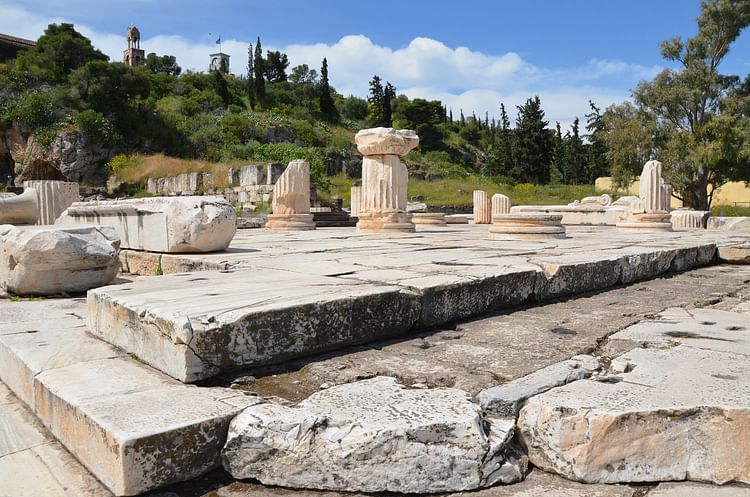
Eleusis was a deme of Athens and most famous for its annual festival of the Mysteries in honour of Demeter and Persephone. The site was also an important fortress protecting Attica and held several other important festivals, notably the Thesmophoria, the subject and title of a comedy play by Aristophanes. The site continued to be an important religious centre through Hellenistic and Roman times, when the site was significantly expanded with monumental architecture being added by several Roman emperors.
ELEUSIS IN MYTHOLOGY
In Greek mythology when Demeter was searching for her daughter Persephone, who had been abducted by Hades, she decided to rest from her weary quest at Eleusis. The daughters of the king, Celeus, offered to help the goddess who was disguised as an old woman. Recuperating in the royal palace, Demeter took a shine to Celeus' infant son Demophon (or Triptolemus) to whom she gave ambrosia and, each night in secret, she held the youth over a fire in order to make him immortal. Demophon's mother happened to see this one night and, misunderstanding the goddess' intentions, banished the old woman from the palace. Not best pleased, Demeter revealed her true identity and ordered Celeus to build her a temple.This was done, and the goddess retreated inside it and brought a terrible drought and famine upon the land, until the other Olympian gods revealed where Persephone was and agreed to release her from the underworld for half of the year. In thanks to Eleusis, the goddess blessed the land and taught the people sacred rites so that the Eleusinians might thereafter prosper both morally and physically. And so the Eleusinian Mysteries were born.
HISTORICAL OVERVIEW
Settlement around the bay and plain of Eleusis began in the Bronze Age, c.1900 BCE, on the Thriasian plain, specifically, on the slopes of the east hill in the southwest corner. From the 16th century BCE the summit was inhabited, and in the 15th century BCE a temple to Demeter was first built coinciding with the reign of the legendary King Celeus, who first founded a sanctuary to the goddess in Homeric tradition. The name of the town derives from the mythical hero Eleusis, whose father was Ogygos, king of Thebes.
THE MOST IMPORTANT FESTIVAL AT ELEUSIS WAS THE ANNUAL MYSTERIES WHICH WERE FAMED THROUGHOUT THE GREEK WORLD.
In the 7th century BCE Eleusis, always strategically important on the route to the Peloponnese, merged with Athens and became the deme of the tribe ( phyle ) of Hippothontis. In the 6th century BCE fortifications were constructed to enclose the Akris hill and sanctuary of Demeter and Persephone (Kore). The fortress was, along with Panakton and Phyle, one of the most important fortresses in Attica. There was also an important theatre of Dionysos constructed at the site. The most important festival at Eleusis was the annual Mysteries, which were famed throughout the Greek world, and c. 600 BCE they became an official ceremony in the Athenian calendar. Solon also aggrandized the site adding a new temple, the Telesterion (also known as the Solonian or Anaktoron for the inner, most sacred room), and enlarging the sacred precinct. During the reign of Pisistratus (550-510 BCE) Eleusis benefitted from the Pisistratan fortification wall with towers and a much larger Telesterion to better accommodate the ever-growing numbers of initiates to the Mysteries.
The site was destroyed during the Persian invasion of 479 BCE but rebuilt under Cimon. Another round of rebuilding was carried out in the 5th century BCE under Pericles, allowing Eleusis to boast the largest building in Greece when the Telesterion was rebuilt on an even bigger scale. Escaping any damage during the Peloponnesian War, the site was again expanded c. 360 BCE, which necessitated a larger protective wall, the "Lycurgan" Wall. At the same time the 6th century BCE Plutoneion building was replaced by a larger structure and the Portico of Philo added.

The Telesterion, Eleusis
Besides the Mysteries (see more below), other important festivals at Eleusis during the Archaic and Classical periods included the Eleusinia (an important biannual games where the prizes were sacred grain), Thesmophoria (an all-female autumn festival in honour of Demeter when pigs were thrown into pits and left to putrefy; their remains were then mixed with seeds before sowing), Haloa (another largely all-female winter festival in honour of Demeter and Dionysos), Kalamaia, and the Proerosia.
In Hellenistic times a Macedonian garrison was stationed at Eleusis, and the Romans, starting with Hadrian, revamped the sanctuary from the early 2nd century CE and added a triumphal arch. Disaster struck when the Telesterion was destroyed in 170 CE by the Costobocs. The temple was rebuilt during the reign of Marcus Aurelius (161-180 CE), and the Roman emperor also oversaw the construction of a monumental gate, an exact copy of the Propylaea of the Athenian acropolis.Other Roman additions included a gymnasium, hostels, and baths. The sanctuary's fortunes declined significantly following the decree of Theodosius I to close down all pagan sites in 379 CE, and Eleusis was destroyed around 395 CE following the invasion of the Visigoths. The town continued to exist for a few more centuries, but the glory days when she enjoyed Pan - Hellenic stature were never to be regained.
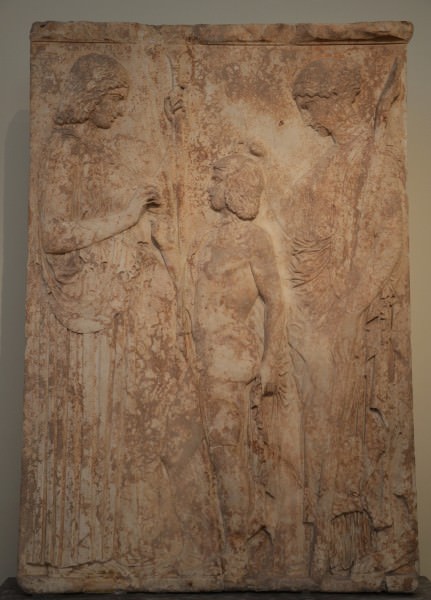
Eleusinian votive relief
THE ELEUSINIAN MYSTERIES
The famous Mysteries of Demeter and Persephone held at Eleusis are just that, a mystery, as the initiated were forbidden from revealing any of the details of the ceremonies involved. We know that from the 6th century BCE, the ceremonies were held twice a year. The first step in the initiation process was known as the "Lesser Mysteries" and held every spring. The more important "Great Mysteries" were held in the autumn over nine days. Only Greeks could be initiated, although this was later expanded to include Roman citizens.
We also know details of some of the outdoor activities and that ceremonies were held under torchlight. There was a procession led by the priestess of Demeter along the Sacred Way from Eleusis to the agora of Athens and another return procession led by a symbolic chariot of Iacchus. There were ritual and communal cleansing and purification ceremonies carried out in the sea at Phaleron, the representation or re-enactment of the myths involving the two goddesses, animal sacrifices (pigs), and the interpretation of sacred texts by priests, the mystagōgoi. There was also probably drinking, music, dancing, and general revelry involved (as with many other such cults in Greek religion ) as attested by pottery scenes of the rites which show initiates holding the "bacchus" or sacred rod. Closely associated with fertility and agriculture, the Mysteries probably brought worshippers good fortune and the promise of a better after-life.
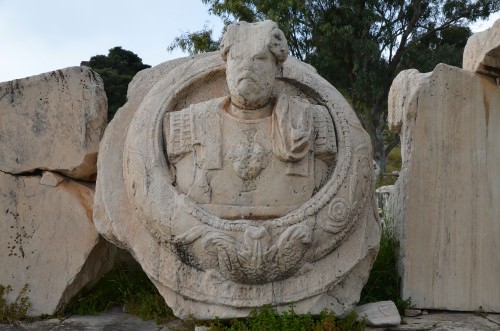
Cuirassed Bust of a Roman Emperor from Eleusis
ARCHAEOLOGICAL REMAINS
The site today is dominated by the large trapezoid Roman court (56 x 54.5 metres), which has a marble slab paving and was the most important structure at the site, the Telesterion. First built in Mycenaean times, the building was rebuilt many times.Today's remains date to the 5th century BCE in plan and later Roman modifications following the destructive fire in 170 CE.We know that there were six entrances, a portico and 14- column stoa, and the upper floor originally had 42 columns. The encircling eight tiers of seats and column bases survive to give a good idea of the original floor plan.
The Greater Propylaea of Eleusis was a copy of the central portion of the monumental entrance to the acropolis of Athens. On the south side of the sanctuary, it had five doorways and was the main entrance. It had a flight of six steps leading to two porches with a façade of six Doric columns on each side and an inner vestibule with six Ionic columns. Decoration was provided via a frieze of triglyphs and metopes and a pediment showing the bust of an emperor (Hadrian, Antoninus Pius or Marcus Aurelius but too weather-worn to identify with certainty) which can still be seen at the site.
Only the foundations and restored parts of the ten column portico remain of the Northeast stoa. Some substantial pieces of the east triumphal arch, built using Pentelic marble, also survive which was once 16 metres high, 4.85 metres wide, and a replica of Hadrian's arch in Athens. Of the opposite arch on the western side only the base and a few fragments remain. Foundations of other structures still present include the northwest stoa, two exedra, the Temple of Artemis and Poseidon, the outdoor altars of Artemis and Poseidon, storage rooms and silos, treasury buildings, and the polygonal stone Kallichoron well. Parts of the Pisistratan wall also survive showing foundations, a section of flat stones, a layer of polygonal blocks of blue-grey Eleusinian stone, and a top layer of bricks.
Surviving art and sculpture from the site include relief panels showing Demeter and Persephone, clay votive plaques depicting rites from the Mysteries, a 5th century BCE statue of a fleeing Persephone from the pediment of the Sacred House, a caryatidfrom the Lesser Propylaea, a 2nd century CE life-size statue of Antinous, and a marble votive pig, all of which can be seen in the Eleusis Museum.
Cultural & Theological Background of Mummification in Egypt › Ancient History
Ancient Civilizations
Many myths and falsehoods concerning the Egyptian practice of mummification have been promoted to the general public in movies, television shows, and documentaries. While these offerings are entertaining and fascinating to watch, the purposes and details regarding the ancient preparation of the dead were quite complex, technically and culturally. Mummification was not merely done to protect the deceased body from decay and decomposition; rather, most ancient Egyptians practiced it—both the rich and the poor—to ensure a successful passage into the next life. Mummification was much more elaborate and far more of a regular, integral part of common Egyptian life than popular culture typically presents.

Mummy of a Child
To gain a full understanding of mummification, the various cultural, religious, anatomical, and pragmatic aspects must be examined. Too often, the focus is solely on the gore and the fantastical lore. Moreover, the Hollywood image of a mummified body being placed in a great vaulted tomb, surrounded by beautifully¬ painted walls, mounds of jewels and treasure stuffed in every corner, the body carefully wrapped with linen and tediously anointed with incense and bitumen, laid in an exquisitely carved sarcophagus of limestone, with vicious deathtraps all about to ensnare and execute the greedy grave –robber, is, generally, a gross exaggeration of the facts in the matter.
THE ORIGINS OF MUMMIFICATION
Certainly, there were funeral sites where the bodies were lavishly treated and surrounded with grandiose stores of wealth and affluence (the prestigious archaeological find of King Tutankhamun ’s tomb by Howard Carter in 1922 attests to this), but the reality is that humble, modest mummification ceremonies occurred more often than lavish ones.
As Wallis Budge states,
After the body had been steeped for a short time in bitumen or natron [a mineral salt], or perhaps merely rubbed with these substances, the few personal ornaments of the man were placed on it, he was wrapped in one piece of linen, and with his staff to support his steps, and his sandals to protect his weary feet in the netherworld, he was laid in a hole or cave, or even in the sand of the open desert, to set out on his last journey. (153-154)
In a culture such as Egypt ’s, which dates back thousands of years, a common question concerns the origins of this unique practice. What most learned egyptologists agree upon is that by the first dynasty, the Egyptians had enough medical and scientific knowledge to preserve the bodily remains of animals (even human) after death. In fact, the peasant magician Teta, during the reign of the first dynasty's second king, Khufu, wrote a book on anatomy and his scientific experimentation with drugs and herbs. Although it is most likely legendary, apparently, scientific inquiry ran in the family - even Teta's mother supposedly dabbled in biological and chemical experiments, eventually inventing an effective hair wash.
THE SOPHISTICATION OF THE MUMMIFICATION PROCESS SPEAKS OF AN OPERATION THAT WOULD HAVE HAD TO DEVELOP AND EVOLVE OVER A LONG PERIOD OF TIME.
Although some historians dispute the notion that mummification dated this far back in the Egyptian timeline, citing many excavated tombs with unprepared, skeletal remains (although these might have been the result of human sacrifice of that period), most believe mummification had been going on for some time— such a complex process of anatomical preservation and culture hardly springs up overnight. The sophistication of the mummification process speaks of an operation that would have had to develop and evolve over a long period of time. Still, there is no specific historical or archaeological evidence to absolutely confirm when Egyptian mummification began.
Due to the religious associations with mummification, one would think that ancient religious documents would provide insight into the inception of mummification, but, once again, its religious origins are murky. Ward states, "The origins of Egyptian religion - we retain the term for lack of a better one - are lost in the pre–literate ages" (117). He further suggests that there is "no 'system' to clarify [Egyptian] funeral theology" (125) because much of its practices developed as the Egyptian polytheistic religion advanced and evolved through the centuries.
THEOLOGICAL BACKGROUND
With said Egyptian polytheism, much theological confusion and uncertainty arose, at times; in the ancient writings, Egyptian thought often appears to contradict itself. Although this might bother some from the Western influence, demanding consistency and empirical data concerning the possibility of the supernatural, a deity (or deities), and the human role in the afterlife, centuries of practice and acceptance show that Egyptians accepted such theological dissonance with ease. As Herodotusremarked, "They are religious to excess, far beyond any race of men..." (Book 2, Ch. 37)
Moreover, the whole idea of the afterlife was more of an effort of appeasement than a guaranteed event in Egyptian religion.Whereas the Judeo–Christian faith system includes (and depends on) a moral sense of balance and soteriology, the Egyptian's position was less tenable but not necessarily terminal. As Perry states,
A crucial feature of Egyptian religion was the afterlife. Through pyramid –tombs, mummification to preserve the dead, and funeral art, the Egyptians showed their yearning for eternity and their desire to overcome death. (12-13)
One of the strongest defining characteristics of the ancient Egyptians was the connection they felt between their lives and their environment. As Perry states, "The Egyptians also believed the great powers in nature—sky, sun, earth, the Nile —to be gods or the abodes of gods" (13). The terrain and climate that surrounded them could be savage and lethal; abundant life was tied into a relatively thin strip of land that depended on clever irrigation and yearly flooding (the gods willing). This preoccupation was further supported by the preserving nature of the Egyptian land, itself.

Male Egyptian Mummy with Amulets
Due to a natural lack of moisture, decomposition in the desert was slow and thus, many living Egyptians would come upon the remains of their descendants, long after their deaths, looking eerily similar as when they were first buried. This most certainly had a strong influence on their view of immortality, which is considered to be the "foundation of Egyptian religion" (Wallis Budge, 173).
THE CONCEPT OF IMMORTALITY
Egyptian culture incorporated this concept of immortality quite nicely into their religious system through the Osiris myth. In fact, a minority of historians believe that Osiris was an actual real human being at one time in Egyptian history—perhaps an ancient ruler who experienced a civil war during his reign, and who received glory and deification post–mortem as the ancients often did for heroes of old. Regardless, the Osiris myth proposed that through the supernatural powers of Horus and the clever vengeful machinations of Osiris' wife, Isis, Osiris became a god and was reborn each year during the Nile's annual flood as Pharaoh of the land. His son, Horus, and his wife, Isis, would also be reincarnated in a continual cycle that guaranteed the royal divine lineage would never cease.
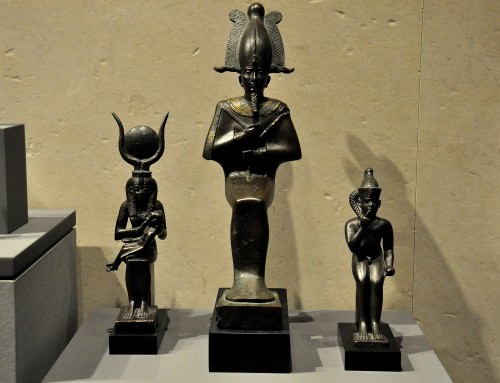
Divine Family from Ancient Egypt
This story was not only empowering to the aristocracy in Egypt but also to all people in Egypt, according to Hamilton–Paterson and Andrews who write that with the great "power" of this myth, "The ordinary Egyptian could easily identify with him [Osiris]" (23). In a severe hierarchical society, it allowed the Egyptian peasant an opportunity to enjoy the good life beyond death, as with the Pharaoh; and joined them together in a divine, eternal religious practice. Evidence of this grand embrace of mummification can be found in such archaeological discoveries as the Valley of the Golden Mummies at the Bahariya Oasis, southwest of modern–day Cairo.
Budge gives a clear description of the purposes behind mummification. He states that mummification was used so that the Egyptian's
soul [ Ba ], and his intelligence [ Ka ], when they returned some thousands of years hence to seek out the body in the tomb, might enter into the body once more, and revivify it, and live with it forever in the Kingdom of Osiris.(Wallis Budge, 159)
To aid in this goal, carefully drawn out funeral rites were carried out to protect and secure the Ka for future life. The Ba was what the mummified body was called after it joined with the Ka. In the Ba, the Egyptian could "take on any shape he chose when leaving his tomb" (Hamilton–Paterson & Andrews, 18). Additionally, the Egyptian Akh was that portion of him which "dwelt among the stars rather than in an afterworld" (Hamilton–Paterson & Andrews, 20). He could, therefore, share immortality with Osiris, although he may not ever be equal to him.
BELIEFS & AFTERLIFE
As referred to earlier, in this process of death and reincarnation involving the Ba and the Ka, a contradiction occurs. Is the dead Egyptian's spirit in the tomb (or wherever the body was placed) or circling around the heavens? The question was unanswered in Egyptian theology. Nevertheless, Egyptians seem to have managed to set aside mutually conflicting ideas of immortality and allow for divine dissonance and limited understanding of the afterlife; however, events such as the dramatic shift to psuedo–monotheism of Akhenaten in the 14th century BCE suggest that Egyptian religious life was not set in stone, ironically.
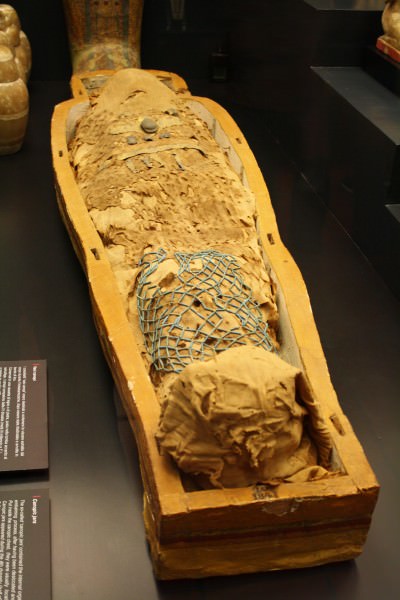
Mummy of Amenirdis
One of the problems in understanding the religious concepts surrounding death and mummification is the impossibility of knowing how widespread and dogmatic these beliefs were in the whole of Egyptian society. Unfortunately, nearly all ancient Egyptian records are from the rich, royalty, or the priesthood. As Hamilton–Paterson and Andrews state, "So much is known about the upper–class ancient Egyptians' lives and culture that there is no longer any room for transcendental speculations" (20); however, the same is not true regarding the beliefs of the peasants in lower Egyptian society. The prevalence of magic and cults (as seen in the multitudinous references in tombs and burial sites) also include references to unheard–of, obscure deities and mystery religions, which suggests that not all Egyptians went along with the Osiris myth theological presumptions.
Still, one can still perceive a common thread in nearly all ancient funeral practices from the Old Kingdom to the New, despite any superfluous differences. Archaeologists and historians have been (and still are) astounded and impressed at the care and delicacy given to the deceased during the mummification process. No doubt, this meticulous and methodical treatment arose in ancient Egypt from a cultural sense of unity and hope in the afterlife, wherein decomposition just "upset so much theology" (Hamilton–Paterson & Andrews, 35).
LICENSE:
Article based on information obtained from these sources:with permission from the Website Ancient History Encyclopedia
Content is available under License Creative Commons: Attribution-NonCommercial-ShareAlike 3.0 Unported. CC-BY-NC-SA License